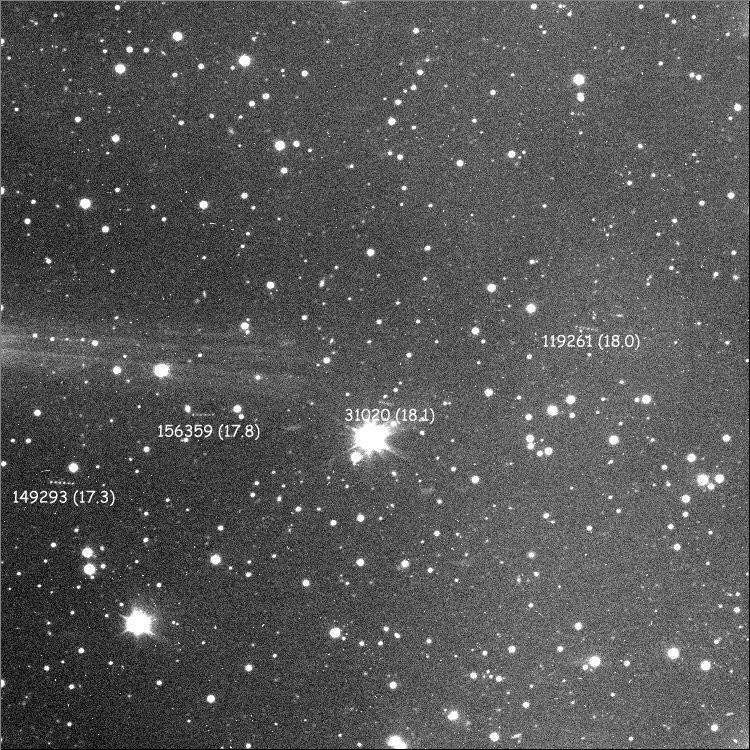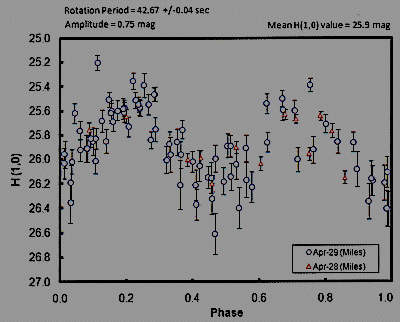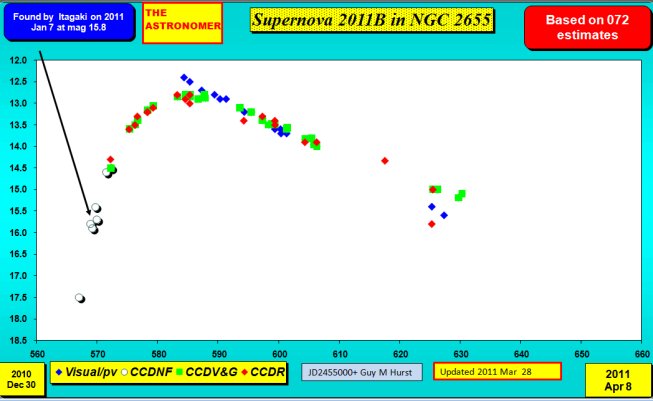Past projects
The following areas of research have been supported by the Robotic Telescope Project:
- Comparison of visual and CCD magnitudes of comets – to demonstrate the proposed BAA Comet Section methodology for extracting visual equivalent or total magnitudes from CCD images.
- Asteroid colour changes associated with rotation – using filtered photometric imaging to determine if asteroids exhibit any systematic colour variations as indicated by their colour indices.
- High ecliptic survey for Edgeworth Kuiper belt objects – continuation of existing survey to fainter magnitudes and detect more EKBOs.

- BAA variable nebulae survey – to establish the variability of these objects in terms of identifying the specific parts of the nebula varying, the frequency with which they change and the variation in brightness encountered. Objects include Gyulbudaghians nebula, NGC 2261 (Hubble’s Variable Nebula) & NGC 6729.
- Investigation on the variability of Gyulbudaghian Nebula – to study the variability of the Gyulbudaghian Nebula and the possible correlation with the variability of PV Cephei both in time and in magnitude variation for at least one year.
- Comet photometry and astrometry – to use the methodology as developed by a group of Spanish amateur astronomers to determine the magnitudes of comets selected, mainly, from the list ‘Comets reaching perihelion in 2010’ published in the 2009 December issue of the Journal of the British astronomical Association. Includes Comet C/2010 X1 (Elenin).
- Confirmation of supernovae – to acquire images of newly discovered supernovae especially if there are problems acquiring confirmation imagery within the UK.
- Photometry of novae and supernovae – this is to extend the study of the decline of these objects as this late part of the light curves has not been studied extensively. In the case of supernovae the disparity with SN Ia in establishing distances and absolute magnitudes appears to be linked to the rate of decline and light curve shape.
- BAA discovery suspects – confirmation of suspects/potential discoveries from BAA members and other groups in need of immediate investigation.
- The recovery of wayward asteroids – if an asteroid has only been observed at a small number of oppositions (say 2) and has not been observed for a number of years, it is likely that its current location will not be known accurately. The purpose of the project is for the support observations of asteroids with large positional uncertainties that have not been observed for a number of years.

- Observations of the eclipsing binary system HS0705+6700 discovered by Drechsel et al (A&A 379,893-904,2001) with a view to completing the determination of the physical properties of the system.
- To monitor comets subject to outbursts in order to improve our understanding of such phenomena.
BAA Robotic Telescope project articles, images and presentations include:
- Journal of the BAA, 2015 October (p284-291), ‘The eclipsing binary HS0705+6700 binary and the search for circumbinary objects’, D. Pulley, G. Faillace, D. Smith, A. Watkins & C. Owen. Errata in BAAJ 2015 December (p385)
- BAA Comet Section Newsletter (The Comet’s Tale), 2014 January (p22), ‘Comet C/2010 X1 (Elenin)’, Roger Dymock
- Journal of the BAA, 2012 April (p110), ‘A revised rotation period for asteroid (2903) Zhuhai’, Peter Meadows.
- BAA Comet Section Newsletter (The Comet’s Tale), 2012 January (p7), ‘Dust to dust – Comet C/2010 X1 (Elenin)’, Roger Dymock.
- BAA Comet Section Newsletter (The Comet’s Tale), 2012 January (p11), ‘Comet 81P/Wild’, Roger Dymock.
- BAA Comet Section Newsletter (The Comet’s Tale), 2012 January (p18), ‘Comet C/2011 L3 (McNaught)’, Roger Dymock.
- Journal of the BAA, 2011 December (p369), Dust to dust – Comet C/2010 X1 (Elenin), Roger Dymock.
- Journal of the BAA, 2011 June (p129), Image of Supernova 2011B, Guy Hurst.
- Journal of the BAA, 2011 June (p127), Image of T Pyxis, Nick James.
- Journal of the BAA, 2011 June (p127), ‘From the President – The Robotic Telescope Project’, David Boyd.
- BAA Winchester Weekend Presentation on the Robotic Telescope Project, 2011 April, Peter Meadows.
- BAA Comet Section Newsletter (The Comet’s Tale), 2011 January (p8), ‘Comet photometry’, Roger Dymock.

- Journal of the BAA, 2010 December (p379), ‘Gyulbudaghian’s nebula – the story continues’, Grant Privett.
- BAA Exhibition Meeting Presentation on the Robotic Telescope Project, 2010 June, Peter Meadows
- Journal of the BAA, 2010 June (p134), ‘Robotic telescope observing with the BAA’, Peter Meadows.
- Journal of the BAA, 2009 December (p347), ‘The rotation period of asteroid (4080) Galinskij’, Roger Dymock.
- Journal of the BAA, 2008 August (p224), ‘Robotic telescopes and the BAA: a remote observing proposal’, Richard Miles and Roger Dymock.

Many schools have contributed observations of comets, most notably of Comet 29P, which work enabled a paper with contributions from 18 schools and colleges to be published in the solar system journal, Icarus (“Anatomy of outbursts and quiescent activity of comet 29P/Schwassmann-Wachmann” by Richard Miles, George Faillace, Stefano Mottola, Herbert Raab, Paul Roche, Jean-François Soulier and Americo Watkins. Vol.272, 327–355 (2016)). See: http://www.sciencedirect.com/science/article/pii/S0019103515005369
Dr. Richard Miles has taught aspects of asteroid and comet studies to 2nd-year undergraduates on three consecutive years (2014-2016) at the University of South Wales using Faulkes Telescope images as source material. Other BAA members have worked with the FTP, for example David Boyd worked with Kennet School, Thatcham, Surrey, on a project on open star clusters, the results of which were published in a paper entitled, “CCD BV photometry of three southern galactic open clusters using Faulkes Telescope South” by David Boyd, Adam Sharpe, George Frost & Alex Dunn (J. Br. Astron. Assoc. 119(4), 212-216 (2009)). See: http://www.faulkes-telescope.com/files/faulkes-telescope.com/flewis/JBAA%20119-4%20Boyd%20et%20al.pdf.
| The British Astronomical Association supports amateur astronomers around the UK and the rest of the world. Find out more about the BAA or join us. |
